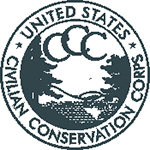History of Sinnemahoning State Park
The original inhabitants called this area Sinnemahoning, derived from the American Indian word “Achsinnimahoni” meaning “stony lick.” The first Europeans to enter the valleys of the First Fork were most likely fur trappers followed by the first few permanent settlers who scratched out a meager living farming the available bottomlands.
The 1800s saw the beginnings of a logging boom in northcentral Pennsylvania; an industry that targeted the abundant old growth pine and hemlock forests. Boom towns sprang up and quickly grew into major centers for commerce and entertainment.
The 1850s ushered in the railroad era for the Sinnemahoning Valley. The Lowlands Trail, which runs the length of the park, was built upon the rail bed of the Goodyear Brothers Railroad, constructed around the turn of the 20th century as part of the Sinnemahoning Valley Railroad System. It later became part of the Buffalo and Susquehanna Railroad and eventually the Baltimore and Ohio.
By the turn of the century, most of the timber had been harvested and huge expanses of once-forested hillsides stood bare and subject to erosion and wildfires. The Department of Forests and Waters (now DCNR) purchased this denuded land for state forest lands.
The people who settled along the First Fork were a rugged, self-reliant group of individuals, as attested to by the area’s most famous resident, Chauncey “Chance” Logue. He was responsible for planting the maples in 40 Maples Day Use Area. Visitors who count the trees will see that Chance actually planted 48 maples. Chauncey’s photo and story can be seen on the display panel near the restrooms in the day use area.
Civilian Conservation Corps

Following the Great Depression, the Civilian Conservation Corps (CCC) began to work in the valley, putting young men back to work. From 1933 to 1936, Lushbaugh Camp, S-130-PA, operated near the present-day site of the Brooks Run Cabin.
History of the Park
Sinnemahoning State Park was developed on the First Fork Sinnemahoning Creek following the completion of the George B. Stevenson Dam. Originally known as First Fork Dam, and later renamed in honor of Clinton County Senator George B. Stevenson who promoted the drive for legislation authorizing the project.
The park opened to the public in 1958. On March 9, 1959, the construction of the recreation areas and facilities were completed. The park then contained three picnic areas with three non-flush toilets, four wells, a beach area, and a boat launching and mooring facilities. In 1966, one picnic area was converted into a camping area.
When the park area first opened to the public in 1958, it was managed by the Bureau of Forestry. In 1962, the park was incorporated into the state park system.
On July 1, 1983, the George B. Stevenson Dam, a state owned and operated flood control dam, was transferred to the Bureau of State Parks for administration.
George B. Stevenson Dam
In 1955, the Commonwealth of Pennsylvania constructed the George B. Stevenson Dam on the First Fork Sinnemahoning Creek as a unit of the general comprehensive plan for flood control along the West Branch Susquehanna River Basin. This plan consists of four reservoirs:
Coordinated operation of the four reservoirs controls a total of 1,163 square miles of drainage area. By controlling the runoff from these areas, these reservoirs provide significant flood prevention to the towns downstream.
In order to achieve best results from the system, all four dams are regulated during floods in accordance with instructions issued by the Baltimore District, U.S. Army Corps of Engineers.
Statistics of George B. Stevenson Dam
- Rolled, earth-fill structure 1,918 feet long
- Maximum height of 166 feet
- Top width of 30 feet and a maximum width of 940 feet at the base
- A 16-foot diameter reinforced concrete tunnel carries the flow of the creek through the right (west) abutment of the dam
- The 211-foot high reinforced concrete control tower houses the two, 37-ton sluice gates and operating equipment
- The conservation pool is maintained at elevation 921 feet above mean sea level (m.s.l.)
- The reservoir has a flood control storage capacity of 75,800 acre-feet (24.7 billion gallons), a surface area of 1,470 acres, and a length of 8 miles
- The flood control storage of the reservoir is equal to 5.85 inches of runoff from the 243-square mile drainage area above the dam